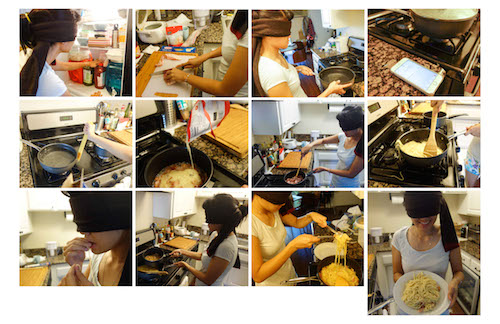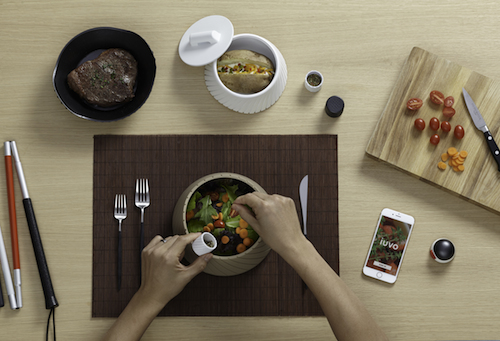
Panoramic shot of students in the Envisioning the Quantified Self class
Graphic Design student Leah Demeter found herself in the unique position of acting as both designer and potential consumer in one of her recent product design classes at Art Center. That’s because her team had chosen a challenge particularly relevant to her: develop a better captioning device for the hearing impaired.
“As someone with profound hearing loss,” Demeter says, “I face communications challenges on a daily basis. Captioning is one of the tools I use to help me follow conversations I would otherwise miss, but there are problems with the current design.”

The team of students behind the Command Glove designed to aid communication among those with hearing loss
Her firsthand experience and access to other users and experts in the field—and being able to provide instantaneous feedback at every step of the design process—propelled her team, dubbed Interface Inyerface, forward. And it resulted in a truly unique concept: Q, a “command glove” that facilitates communication by projecting captioning directly onto the user’s hand.
Product Design student and fellow team member Jeff Smith notes that the new design concept fundamentally changes the way the user is able to interact with others. “Ultimately,” he says, “the project became about increasing social inclusion, a need that everyone has that goes beyond the issues of hearing.”
The students’ captioning concept was recently endorsed by the John Tracy Clinic, a leading diagnostic and education center for young children with hearing loss. The Interface Inyerface team, which also includes Product Design students Emin Demirci and Daniela Cardona, is now pursuing funding to develop a working prototype as the next step toward bringing the product to market.
The name of the class, “Envisioning the Quantified Self,” refers to the fast-growing movement of using technology and data acquisition to help people monitor their own health and well-being. “As people become more and more responsible for the management of their own care,” explains Jeff Higashi, who taught the course with fellow Art Center Product Design faculty Brian Boyl, “designers need to be there to think through ways of making health products more user-friendly.”
Higashi and Boyl asked students to take a systems-level approaching to developing their products.

Students documented the experience of cooking without sight
For Della Tosin (BS 15 Product) and her team, that meant applying their creative and problem-solving energies toward making life in the kitchen easier, safer and more satisfying for people who are visually impaired. “We realized there was a big opportunity to redesign the cooking experience for the blind,” she says. “At the same time, we wanted to inspire a healthy lifestyle.”
Her team’s IUVO concept is an “open source network” that enables the visually impaired and blind to customize the cooking experience, facilitates ingredients according to the user’s health need and provides guidance along the way.
Empathy played an important role in both projects. Demeter recalls her team conducting a social experiment as part of their design process: “My teammates with normal hearing went an entire day at school wearing earplugs. They were able to experience problems related to hearing loss first hand. It was frustrating for them and I think being able to relate to my challenges even in a small way served as inspiration.”

The IUVO team conducted similar experiments, cooking and doing other related activities with their eyes closed. “After numerous trials and observations, we realized that it was very possible to solve these challenges by getting outside our comfort zone,” says Tosin.
For Smith, the team-based nature of the class resulted in better design. “Instead of brainstorming individually, we brainstormed on gigantic sheets of butcher paper, all of us sketching simultaneously,” he says. “The ideation process enabled us to riff off each other’s ideas in a way that wouldn’t have been possible otherwise. It got us to a place any one of us could not have gotten alone.”
“Collaborating with my talented teammates challenged me to push the envelope and come up with unexpected solutions that I wouldn’t have thought of as a user,” Demeter adds. “The prospect of our design becoming a real product is exciting to me personally, because it could change the lives of people with hearing loss for the better, including myself.”
Art Center is grateful for grant support from VentureWell in support of the Envisioning the Quantified Self.









I am very impressed with this direction. Communication is the beginning of understanding. Hearing, seeing highlight this. Your ACCD exploratory could become a “major” direction and very necessary as the baby boomers age.
Chuck
Adv’64
Dept Chair
’76-’80